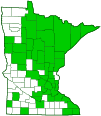Deceiver
(Laccaria laccata)
Conservation • Description • Habitat • Ecology • Distribution • Taxonomy
|
|
||||||||||||||
Description |
Deceiver is a very common, often abundant, small, edible, gilled mushroom. It occurs worldwide but is most common in Europe and North America. In the United States it occurs east of the Great Plains and west of the Rocky Mountains, and there is a disjunct population in the Denver, Colorado area. It is common in Minnesota. It is found from late spring through fall; alone, scattered, in groups, or occasionally clustered; often in woodlands but in a very wide variety of habitats. It grows on the ground in dirt or duff under or near hardwoods or conifers. Mushroomers sometimes consider it a “weed” mushroom due to its ubiquity, abundance, and “lackluster” appearance. One of its common names is Lackluster Laccaria. When it first appears, the cap is convex. The upper surface may be bald or be moderately covered with fine hairs or minute scales. The color is highly variable. It may be shades of brown, orangish-brown, reddish-brown, pinkish-brown, or salmon-colored. The tissue is dark and more or less transparent when moist, becoming paler and opaque as it dries out (hygrophanous). The margins are curved inward. As it ages, the cap spreads out and the color fades. The mature cap is usually ⅝″ to 2″ (1.5 to 5 cm) in diameter but it may be larger or smaller. It is often depressed in the middle. The color is buff when dry, becoming darker when moist. The margins are curved downward and may be smooth, lined, or grooved. On older caps the margins are sometimes uplifted, sometimes wavy, and often eroded or lobed. Like the genus, this species is called “Deceiver” due to its tendency to fade and become difficult to identify. The gills are thick, well-spaced, and somewhat waxy. They are usually broadly attached (adnate), sometimes slightly running down the stalk (decurrent), sometimes abruptly narrowed where they attach to the stalk (notched). They are pale pink to flesh-colored or reddish-tan when young, becoming dusted white as the spores mature. The stalk is tough, flexible, often twisted, usually slender, ¾″ to 4″ (2 to 10 cm) long, and ⅛″ to ⅜″ (3 to 10 mm) thick. It is more or less the same thickness from top to bottom. It is colored like the cap and usually covered with fine hair-like fibers (fibrillose). There are sometimes downy white fibers, part of the mycelium, at the base. As it ages the stem becomes hollow. The flesh is thin and the color of the cap but paler. The cap is edible, but care should be taken as it looks like many other mushrooms. The stems are tough and are not considered edible. The spore print is white. |
Similar Species |
Habitat and Hosts |
A wide variety of habitats. Hardwoods and conifers. |
Ecology |
Season |
Late spring through fall |
Distribution |
||
|
Sources |
|
| 4/30/2025 | ||
Occurrence |
||
Very common, often abundant |
||
Taxonomy |
|
Kingdom |
Fungi (Fungi) |
Subkingdom |
Dikarya |
Phylum |
Basidiomycota (Basidiomycete Fungi) |
Subphylum |
Agaricomycotina (Higher Basidiomycetes) |
Class |
Agaricomycetes (Mushrooms, Bracket Fungi, Puffballs, and Allies) |
Subclass |
Agaricomycetidae |
Order |
|
Suborder |
Agaricineae |
Family |
Hydnangiaceae |
Genus |
Laccaria (deceivers) |
The genus Laccaria was formerly placed in the family Tricholomataceae, a waste-basket family containing a large number of genera that do not fit into another family or have not (yet) been separated into a distinct family. Some authors placed it into a separate family, Hydnangiaceae, based on its unique spore type. Subsequent DNA studies support this separation. |
|
Subordinate Taxa |
|
|
Deceiver (Laccaria laccata var. laccata) Deceiver (Laccaria laccata var. pallidifolia) |
|
Synonyms |
|
Agaricus laccatus Camarophyllus laccatus Clitocybe laccata Collybia laccata Omphalia laccata Russuliopsis laccata |
|
Common Names |
|
Deceiver Lackluster Laccaria |
|
Glossary
Fibrillose
On mushrooms, covered with fine hair-like fibers.
Hygrophanous
Referring to mushroom tissue that is dark and more or less transparent when moist, becoming paler and opaque as it dries out.
Mycelium
The vegetative part of a fungus; consisting of a mass of branching, thread-like hyphae, through which a fungus absorbs nutrients from its environment; and excluding the fruiting, reproductive structure.
Visitor Photos |
||
Share your photo of this fungus. |
||
This button not working for you? |
||
Dan W. Andree |
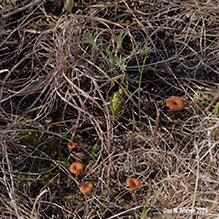 |
Little brown mushrooms... These were growing in the area not burned recently at Frenchman’s Bluff SNA. They were very small. |
Honey Fae (Farah) |
||
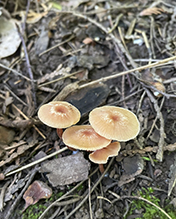 |
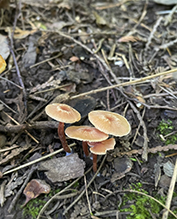 |
|
Luciearl |
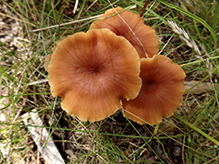 |
MinnesotaSeasons.com Photos |
||

Slideshows |
|

Visitor Videos |
||
Share your video of this fungus. |
||
This button not working for you? |
||
|
Other Videos |
||
LACCARIA - The most underrated wild mushroom? |
About
Jun 12, 2022 Laccaria is an often overlooked edible mushroom here in the Adelaide Hills in South Australia. Many people think it takes too long to collect enough for meal and due to a mild flavour is a waste of time. I personally disagree and can bag out in a matter of minutes provided we get a good flush which we do most years. So in this video I show you everything you need to know about how to correctly identify and harvest Laccaria Laccata/Fraterna! YEAH! |
Laccaria laccata, commonly known as the deceiver, or waxy laccaria |
About
Jun 5, 2019 Laccaria laccata, commonly known as the deceiver, or waxy laccaria I go through the forests, mountains, hills, fields, and waters to understand the living world and to create a living mind. I'm just a man who is on passing on this living earth. A living earth that is closer to death, because of us, of the human being. I spend all my time in nature, enjoying its show. All this time I try to make a video encyclopedia with flora and fauna that I encounter on this living earth. Sometimes with human fauna ... I meet wild mushrooms, medicinal mushrooms, edible mushrooms, dead mushrooms, toxic mushrooms, magic mushrooms. Every wild mushroom with its mystery and story. The living earth is still amazing. I meet plants, flowers, trees, shrubs, grass, leaves fallen on the living land, leaves fallen on the dead land, leaves that dance in our thoughts and soul. I meet insects, invertebrates of all kinds, butterflies, worms, larvae, birds, fish, mammals, reptiles, amphibians... But I also encounter deforested forests, hunters, poachers, animals killed, tormented, in a suffering that words can not express. I also meet people who think it is good that they behave like this. I stretch my hand and save an insect from the drowning. But this people trample under foot my hand. They make their choice. I make my choice. Sometimes I manage to correctly identify the species of living beings: mushrooms, plants, animals, insects. Sometimes not. What I know is much less than what I do not know. I am just a man in front of a knowledge that surpasses me, overcomes us. I do not know enough English yet to make my clips more attractive. But I'm learning...A wonderful life, I wish you all! |

Visitor Sightings |
||
Report a sighting of this fungus. |
||
This button not working for you? |
||
Dan W. Andree |
Location: Frenchman’s Bluff SNA These were growing in the area not burned recently at Frenchman’s Bluff SNA. They were very small. |
 |
| Honey Fae (Farah) 8/21/2022 |
Location: Duluth, MN |
 |
| Luciearl 8/28/2019 |
Location: Cass County |
 |
MinnesotaSeasons.com Sightings |
||
|

Created: 1/26/2023 Last Updated: © MinnesotaSeasons.com. All rights reserved. |
